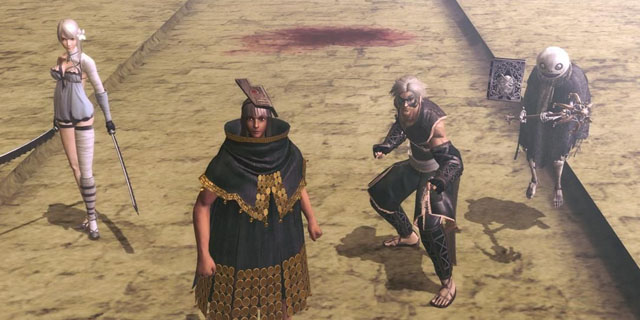
It must be an incredibly daunting task to make a video game. Forget the fact that it normally takes an enormous amount of effort and finances to get the project to completion. How do you manage to make it good? If it were easy, everybody would do it. And despite the fact most games lie in the “6.5-8.0” range, that doesn’t mean they’re good. Video game review scores are a fickle beast, at best. Hundreds of people are involved in making games at a creative level, so how do you unify them all to make a game with a common goal in mind? Do they all agree on the same thing? Impossible. Picture a group of ten of your friends. Now ask if they all want to see the same movie. Right.
Many issues will be dealt with on the fly, many will be planned and then scrapped, and what’s left over is a video game for us to play. What we see isn’t a coincidence, or an accident; it was a result of many people working very hard for many years. In a way, we are seeing them, just as we hear Hans Zimmer when Inception‘s main theme plays. Or how we see Bobby Fischer, not sitting at the chessboard, but through his moves on the board. The pieces are him.
As a result, some games are “good” and some are “bad”. But what about the others? The ones that fall into the gray area? There are so many games that are just “meh,” but I don’t want to talk about those today. I want to talk about games where you’re unsure if you enjoyed it or not. You can’t tell if it’s brilliant or terrible. Is it either? Whatever it is, it’s unique. It doesn’t fall into the normal categorization of positives and negatives. It’s a spectacle. I’m still not sure if I liked these games or not, but I’m still thinking about them. Nier is one of those games.
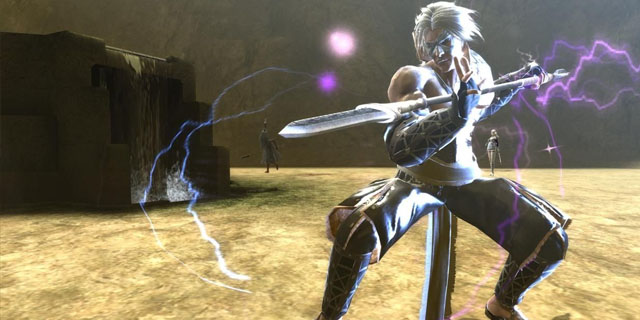
Nier is a 2010 action-RPG that might be the strangest game I’ve ever played. You take control of Nier, a middle-aged warrior who is trying to cure his daughter, Yonah, from a deadly illness. You journey across fields, through towns and dungeons, meeting allies and swinging swords. Okay, you’re saying, what’s so weird about that? Did I mention that you start the game 1,312 years in the past as the same character? Or how about one of the allies you meet is a talking book, easily one of the most entertaining characters I’ve seen in a long time, named Grimoire Weiss? Or the fact that there are four endings, each one building on each other, revealing more information about the story and characters?
I can’t justly define what makes Nier a spectacle. There are so many oddities about the game that you’re not even sure what genre it is. At first it seems like a typical action-adventure game, but then there are fighting sections that remind you of a hyper-action game like God of War. Then there’s the dungeon that’s an obvious homage to Legend of Zelda.
How about the basement that changes the camera angle to make it look oh-so like Diablo? One boss fires so many projectiles your way, you feel like you’ve been thrown into a bullet-hell shooter, where the primary objective is to survive the impossible onslaught of enemy fire. And, believe it or not, there’s even a text-based dungeon that requires you to read a large amount of information and answer questions about it. That’s right, a text-based level. Is this 1973?
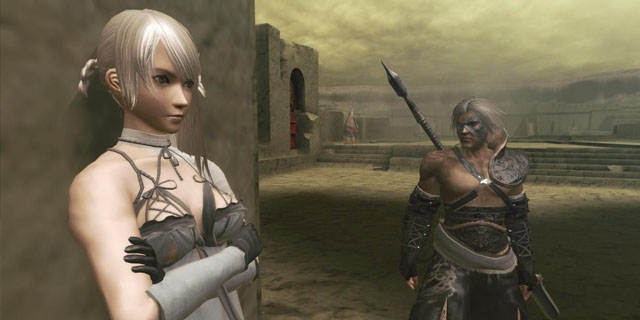
I felt like my opinion of Nier changed by the hour. Sub-par graphics? Bad. Beautiful, original, haunting music? Good. Constant backtracking through the same area? Bad. Switching up the camera angles and gameplay styles? Good. Wholly original characters? Good. Awful fetch quests and lame townspeople? Bad. Customizable stat bonuses? Good. Mindless combat against low-level enemies? Bad. Crazy twists in the storyline? Good. Ridiculous jump animation? Bad. I’m not even halfway through my list of all the pros and cons of the game, but you get the picture. Here is a game that is the definition of a mixed bag.
When making a game, should one strive to be different? Does one take a risk and introduce a new gameplay mechanic, or play it safe and emulate best sellers? Do we, as gamers, prefer games that take these risks or play it safe? A flawed-but-innovative product like Nier is an example of developers taking a risk. They wanted to make more than just a typical action-RPG, and it shows. It’s ambitious and strange, but it sticks. I won’t forget it anytime soon, and I could see myself going back to it. Is that the end goal for developers? Beyond making a game that sells well, don’t they want it to be remembered, if not for the best reasons?
I don’t even know if there’s an answer to this, let alone a right one. Ambiguity and confusion reign in this article, but also respectful curiosity. This is how I felt when playing another spectacle, Folklore.
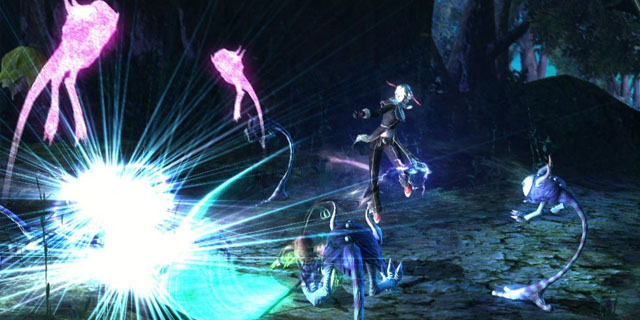
Folklore is another action-RPG, and a PS3 exclusive. Released early (before anybody you knew had one) in the console’s lifecycle, it was a brand new IP with almost no marketing, and to nobody’s surprise, almost no sales. Now let me try to accurately portray what Folklore is.
It’s sort of a combination of Pokemon, The Muppets and Murder, She Wrote.
Wait, no.
It’s sort of a combination of Labyrinth, Fraggle Rock and Law and Order.
That can’t be right.
How about A Christmas Carol, The Neverending Story and The Nightmare Before Christmas?
I forfeit this incredibly fun activity, because it’s impossible to win. Folklore is a spectacle, an oddity. A blip on the radar of normal. It’s a spike on the EEG of sensible plot design. But it works. Sort of.
You play as two characters, Keats and Ellen. They come separately to the mysterious, quiet village of Doolin to uncover a mystery. Each has multiple chapters to go through, and you can pick which order you want to play through. Once you finish Ellen’s Chapter 1, do you go onto Chapter 2? Or do you see what Keats is up to?
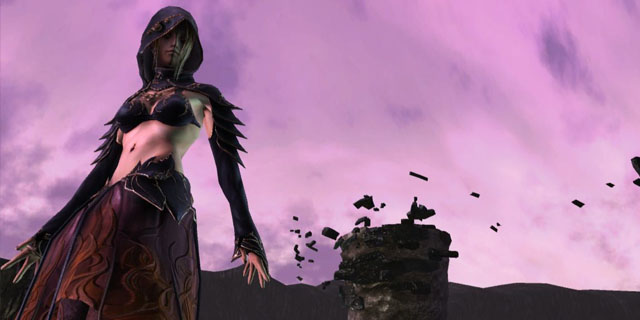
The village is one of those places you hope to stumble upon when going for a walk along the cliffs. You have to be alone, and it has to be daytime, but it also has to be cloudy. Sunshine or nightfall would ruin the atmosphere. People don’t live here anymore, but they used to. Or still do, but don’t open their doors. You’re not sure you want to find out. The grass grows high, but not too high. Waves remind you you’re still on this planet. You want to flee after a few moments, but you wish you’d been raised here. It feels fantastic, but sad at the same time. It’s a great backdrop for a hub.
It’s not where most of the action takes place, however. Ellen and Keats have to solve the mystery by seeking memories of the dead in the Netherworld, a parallel universe populated by dangerous and freakish looking “Folk.”
So we have realistic characters who seem very normal (Ellen does, anyway). They come to a village that you could find in England or Wales. They come to solve a mystery. And at night, the pub is patroned by ghosts who will talk to you and give you quests. You travel to the Netherworld where you absorb the souls of defeated Folk and then use them in combat against other Folk. Some Folk’s weaknesses are specific Folk.
You absorb their souls, traverse through dungeons and when the level is over…you’re back in the village. More hints, clues. Solving mysteries, raising the dead, absorbing souls for combat in a warzone, in Atlantis, in a forest. Ellen and Keat’s Folk differ, as do their perspectives of the story. Not sure what happened when Ellen “fixed” one particular level? Maybe Keats will find out. Is that Ellen’s mother? Why is a demonic scarecrow helping us? Faerys, Folk and murders in the real-life village add intrigue to an already intriguing game.
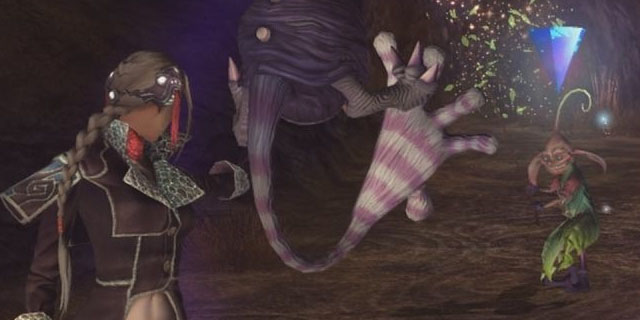
Folklore isn’t great; you get the feeling the developers needed more time with the PS3. The premise is wonderful, but the combat and gameplay doesn’t quite match. The graphics aren’t offensive, but they’re nowhere near as good as current PS3 games.
Folklore isn’t bad; a rare appearance of the Sixaxis controls works fairly well when shaking the souls from Faerys and Folk. The art direction is fantastic; the Nethworld’s denizens look like something right out of Jim Henson’s workshop. Or from The Nightmare Before Christmas. Or Labyrinth. The concept of capturing enemies, then using them against other enemies is a gameplay trope that won’t overstay its welcome anytime soon. You haven’t played anything like Folklore.
No risk comes without consequences. The developers of Nier and Folklore are now both defunct. Neither game sold well. They’re not in my top 100 games I’ve played. And yet… here we are. I’m writing about them. I remember specific details, like the noise of a menu confirmation in Nier and the main theme of Folklore.
Treat yourself to a listen.
The main areas are still there in my head. I’m willing to bet Nier and Folklore will still be residing somewhere in my conscious mind years from now. How many games can say that? Is this what the creators of the games wanted? Did they start out thinking they were going to make a great game, but got sidetracked and found something else? Is this a representation of them? Or did they never find that unifying vision, and as a result, we get what we got?
Success and failure doesn’t describe either game. They’re undefinable, weird, spectacles.



















